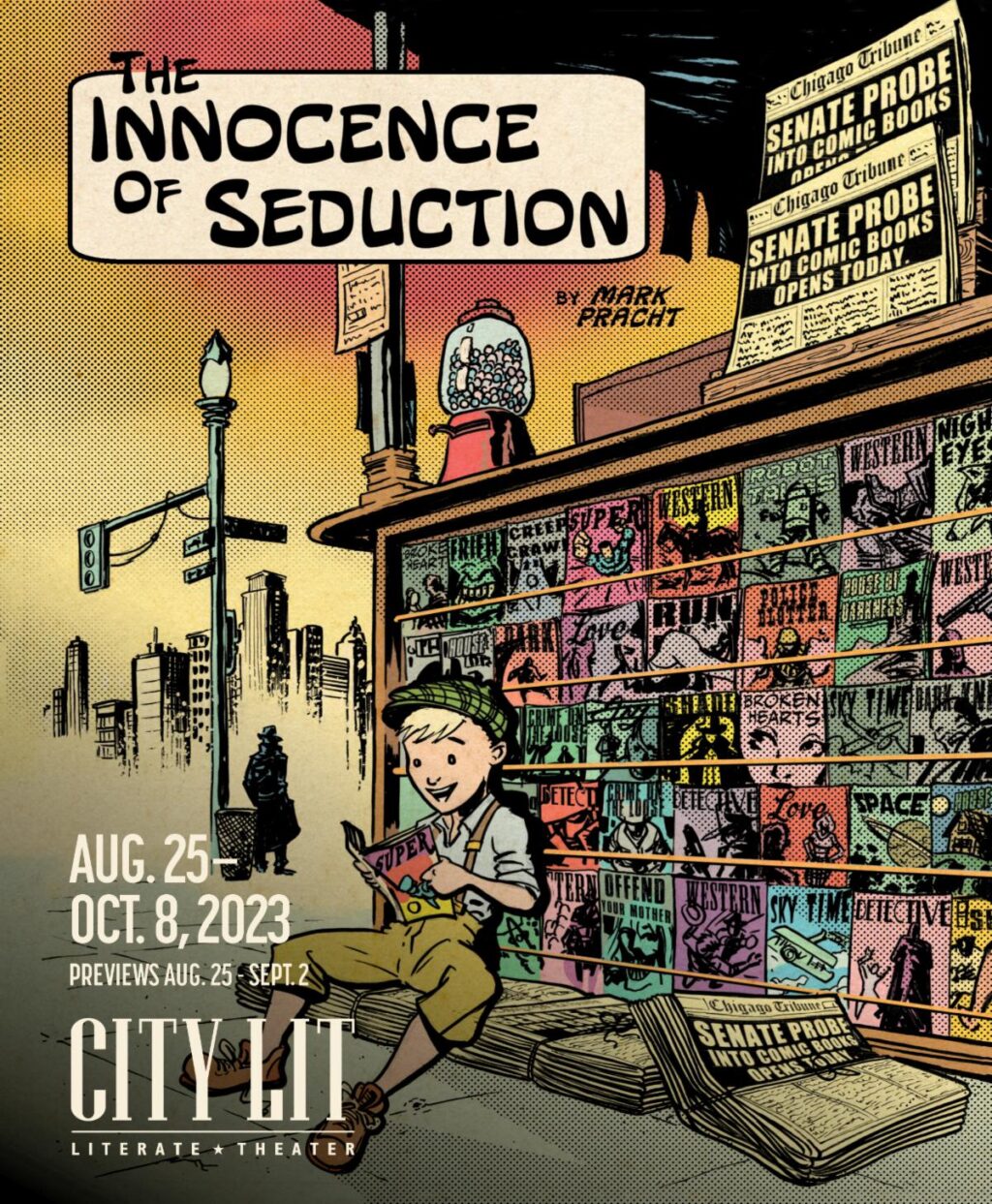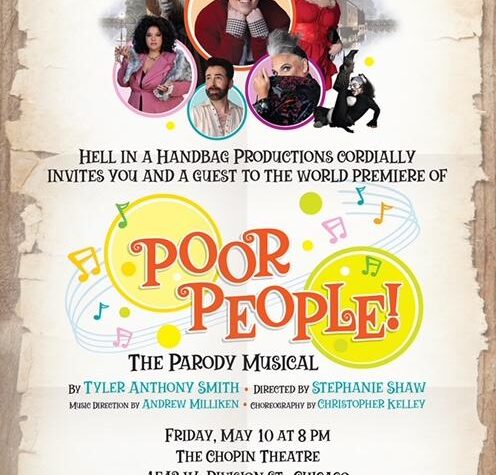
 **** Mark Pracht’s second installment of his study of comic book history focuses on the 1950s and horror comics that feature crime, mutilation, sex, and death—plus zombies, werewolves, monsters, and the like. Entitled “The Innocence of Seduction”, the play largely focuses on Bill Gaines (Sean Harklerode), who originated the horror genre as the owner of Entertainment Comics, or EC, a company which he inherited from his father. We watch what happens to Gaines and his rival comic book publishers as they band together in reaction to Congressional hearings on whether reading the comics can be linked to juvenile delinquency. While playwright and director Pracht implies that there is no evidence for such a causal connection, the thrust of his show has to do with the horrors of censorship as an infringement on our Constitution’s guarantee of freedom of speech and expression.
**** Mark Pracht’s second installment of his study of comic book history focuses on the 1950s and horror comics that feature crime, mutilation, sex, and death—plus zombies, werewolves, monsters, and the like. Entitled “The Innocence of Seduction”, the play largely focuses on Bill Gaines (Sean Harklerode), who originated the horror genre as the owner of Entertainment Comics, or EC, a company which he inherited from his father. We watch what happens to Gaines and his rival comic book publishers as they band together in reaction to Congressional hearings on whether reading the comics can be linked to juvenile delinquency. While playwright and director Pracht implies that there is no evidence for such a causal connection, the thrust of his show has to do with the horrors of censorship as an infringement on our Constitution’s guarantee of freedom of speech and expression.
Pracht has created a number of characters in this play who are exaggerated counterparts of the real people on whom they are based. One such character is Dr. Fredric Wertham (Frank Nall), who, with his overly moralistic commentary and ghoulish presence, constantly returns to the stage as narrator and critic. This character could have easily been taken from the pages of the comics which he decried. Since the show is meant to turn Wertham on his head, Pracht transposed the author’s book title “The Seduction of Innocence” into the “The Innocence of Seduction.” Then there is Bill Gaines’s deceased father Max (Ron Quade), who constantly winds up in his son’s bloody nightmares. Were these nightmares the inspiration for Gaines’s focus on horror—or did they arise subconsciously from guilt, due to his radical departure from his father’s educational and religious teachings? We never learn the answer in this play—nor should we.
We also never learn whether or not there was actually an uptick in juvenile crime and delinquency (however defined) during the 1950s. If so, there may have been some reasonable rationale behind U.S. officials trying to discover its roots, if only to grasp at straws. What is mentioned in the show, however, is that Senator Estes Kefauver might have been positioning himself for a Presidential run, and it was hinted that his use of a cultural wedge issue might be helpful in getting him name recognition. Yet the question in the back of my mind had to do with American public opinion. I wondered what eventually convinced distributors to no longer ship comic books to drugstores and newspaper stands. And did the general public feel the same way? Or, like today, were they divided along political and cultural lines?
While I liked watching “The Innocence of Seduction”, I often found it overly ambitious. In the first act, so much comes at the audience faster than we can comprehend it—and I was not alone in feeling the need for more background about the subject matter. At the very least, I wanted to keep a scorecard of all the characters. The show has a total of 22, and actors double-up on roles to play them all. Rounding out the list of actors are: John Blick, Andrew Bosworth, Paul Chakrin, Laura Coleman, Charlie Diaz, Jessica Lauren Fisher, LaTorious Givens, Zach Kunde, Chuck Munro, and Robin Treviño. Threads start coming together plotwise towards the end of the first act and later during the second, once we understand the implications of the Senate probe and how the industry must band together to fight for its livelihood. We witness what happens when Gaines gives voluntary testimony before Congress. We become aware of lots of people losing their jobs and the toll that this took on their careers and personal lives. We learn about the origins of the industry regulating itself through self-censorship and the creation of the seal of Approval by the Comics Code Authority.
This is a rather deep show that keeps our interest with its focus on dark humor. It is more of a commentary on the comics of the day and an advocacy piece against censorship as compared to being a true-to-life historical and cultural portrait of what was happening seventy years ago. In addition to discussing corporate and political interests inherent to the comic book industry, this play reveals the characters’ personal lives in relation to their chosen profession during that era. For example, Janice Valleau (Megan Clark) is a super-talented artist who is discriminated against because she is female. Matt Baker (Brian Bradford), who is also super-talented, has to deal with discrimination as both a black man and a closeted gay man.
Costumes by Beth Laske-Miller work well for the time period and differentiate actors who play multiple roles. Sound design by Petter Wahlback could not have been better! I especially loved Tony Donley’s cover/poster illustration advertising the production. Pracht’s directing is wonderful: He uses all portions of the small stage to smoothly relate the tale. The scenic design is great, thanks to the fantastic work of G. “Max” Maxin IV, who also handles the lighting and projection design. Excellent props design by Jeff Brain add to both the realism and the illusion. The stage is divided into four sections: stage right being the office of Entertainment Comics (formerly Educational Comics) with an oil painting of the founder prominently displayed; stage left being the office of Quality Comics with comic strip frames hanging on the wall; and center stage being mostly devoted to St. John Comics. The front of the stage is used when all of the principals get together to discuss business interests in common. In addition, an invented television set at the rear of center stage establishes the various locales where the action takes place. The TV set also displays various and sundry frames taken from the original comic strips. To my mind, the set should have also been used to broadcast headlines and statistics on the spate of delinquency that America was going through (or not).
Over the years, there has been no shortage of speculation on just how impressionable our youth may be and just how poorly (or well) they might be able to handle controversial or shocking ideas. At a time when school libraries have been trimmed and book bans have become rampant, the question on the table is who should make the decision about what is appropriate for children to read, view, listen to, or participate in? What is the role of parents, teachers, government, and the media? The government investigation into 1950s comics leading up to the creation of the Comics Code Authority thus resembles arguments being made about Hollywood movies in the 1960s and 1970s; such that voluntary film ratings were adopted by the Motion Picture Association of America in 1968 and later tweaked—and thus we are all familiar with G, PG, PG13, R, and NC17. Then, in the 1980s and 1990s, there were discussions about the possible effects of violent video games on youth. Nowadays, significant conversations are taking place about placing age restrictions on those who use social media. Should sites like Facebook, Instagram, X, Tumblr, and others be restricted to those 16 years old and over? And why 16? Thirteen was once considered the magic number, but note that the median age of school shooters is 16! (Might there be a connection between the use of social media and school shootings—and how would we know?)
Today, the jury is still out on issues regarding age-appropriate books and social media, while the debate rages on as to who may have an interest in censorship and why. But as with comic books and movies, any form of restriction is always steeped in controversy. If censorship is brought to bear on what (suggestible) youth can see and hear, then this can become a slippery slope that may soon restrict the freedom of expression that adults have: with the unfortunate consequence that ideas might be stifled and personal liberty constrained. Overall, “The Innocence of Seduction” gives us a tremendous amount to think about.
“The Innocence of Seduction” is playing through October 8, 2023, at City Lit Theater, 1020 W. Bryn Mawr Avenue, in Chicago, on the second floor of the Edgewater Presbyterian Church.
Tickets $34, Seniors $29, Students and Military $12 (all plus applicable fees)

Performance schedule:
Fridays and Saturdays at 7:30 p.m.
Sundays at 3:00 p.m.
Mondays September 25 and October 2 at 7:30 p.m.
For more information or to purchase tickets, visit https://www.citylit.org/ or phone 773-293-3682.
To see what others are saying, visit www.theatreinchicago.com, go to Review Round-Up and click at “The Age of Innocence”.






More Stories
“Poor People ! The Parody Musical” Reviewed by Julia W. Rath
“Last Stop on Market Street”
“Miz Cracker” at The Venus Cabaret